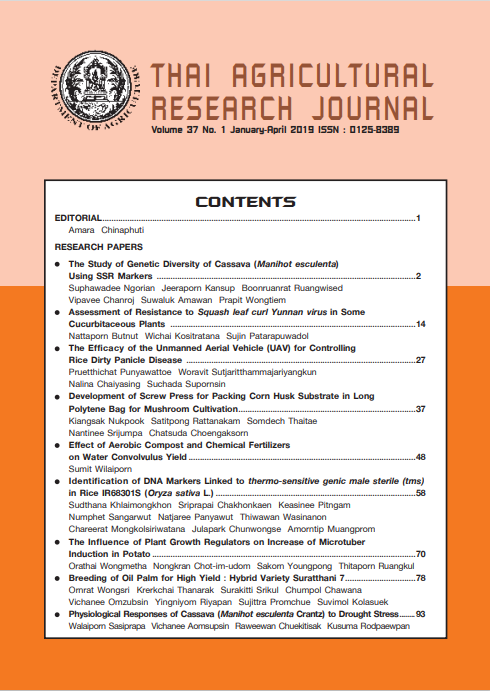Assessment of Resistance to Squash leaf curl Yunnan virus in Some Cucurbitaceous Plants
DOI:
https://doi.org/10.14456/thaidoa-agres.2019.3Keywords:
Cucurbits, Squash leaf curl Yunnan virus, Disease resistanceAbstract
The distinct species of begomovirus named Squash leaf curl Yunnan virus (SLCuYV) was detected in Thailand. It caused yellow leaf curl diseases of commercial varieties of various cucurbitaceous plants and led to severe losses in both fruit quality and yield. The virus spreads widely across the country due to the effective transmission by whiteflies (Bemisia tabaci). Breeding for resistance of plant is the most effective approach to reduce disease loss. The aim of this study was to assess the resistance of pumpkin, wax gourd and ridge gourd cultivars to infection by SLCuYV isolateTH-PK-2018 (SLCuYV-TH-PK-2018) under greenhouse conditions. A total of 152 accessions including 106 of pumpkin (Cucurbita moschata), 39 of wax gourd (Benincasa hispida), and 7 of ridge gourd (Luffa acutangula) were evaluated for SLCuYV infection by whitefly transmission. Ten to fifteen adult whitefies were provided a 48 hour acquisition access period (AAP) initially on the symptomatic pumpkin plants, and then transferred to each healthy seedling at the first true leaf stage for a 72 hour inoculation access period (IAP). The presence of SLCuYV in inoculated plants was determined by using the enzyme-linked immunosorbent assay (ELISA) and the symptoms were scored at 4 weeks post inoculation. Virus infection index based on percentage of disease index and vulnerability index classified 20 resistant accessions including 3 of pumpkin, 10 of wax gourd and 7 of ridge gourd.
Downloads
Published
How to Cite
Issue
Section
License
Copyright (c) 2019 Thai Agricultural Research Journal

This work is licensed under a Creative Commons Attribution-NonCommercial-NoDerivatives 4.0 International License.
Thai Agricultural Research Journal



